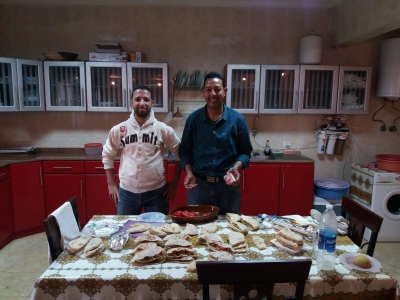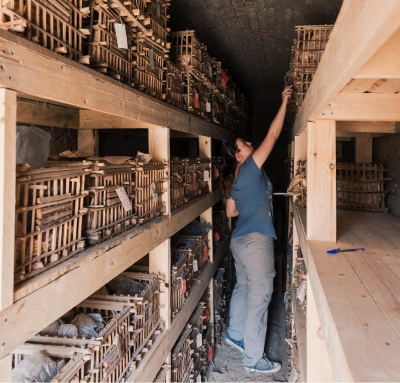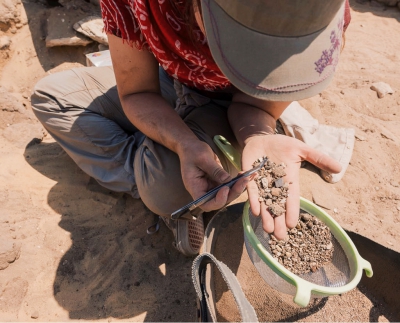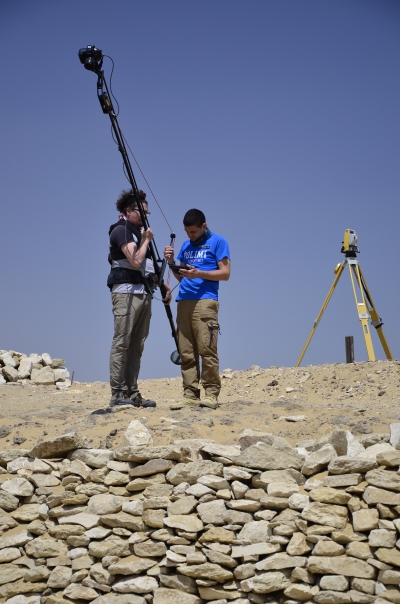Extra Lecture Ramadan Hussein
This lecture addresses briefly the status of Egyptological textual research in light of ideas generated in both traditional Philology and ‘New Philology’.


| 09:00-09.45u | Inschrijving en ontvangst met koffie/thee | |
| 09.45-10.00u | Opening 16e Saqqara-dag door de voorzitter van Friends of Saqqara | Vincent Oeters
|
| 10.00-10.45u | The Saqqara Saite Tombs Project: Recent Discoveries (Engelstalig) | Ramadan Hussein |
| 10.45-11.15u | Pauze met koffie/thee | |
| 11.15-12.00u | Facebook voor het hiernamaals: Netwerken van elitegraven in het Oude Rijk | Nicky van de Beek |
| 12.00-14.00u | Lunchpauze (op eigen gelegenheid) | |
| 14.00-14.15u | Korte presentatie | Willem Hovestreydt |
| 14.15-14.30u | Opnieuw een kleine ibis-surpise | Rob Demarée |
| 14.30-14.45u | Een corpus van reliëfs uit Memphis: Nieuws uit het archief van Geoffrey T. Martin | Nico Staring |
| 14.45-15.15u | Pauze met koffie/thee | |
| 15.15-16.15u | Verslag van het opgravingsseizoen 2018 in Saqqara door de opgravingsleiders | Lara Weiss |
| 16.15-16.30u | Loterijtrekking | |
| 16.30-18.00u | Afsluitende borrel | |
| vanaf 18.00u | Diner in restaurant Verboden Toegang (optioneel) |
Donateurs gratis, studenten € 5, anderen € 10 entree (incl. koffie en thee, excl. lunch en diner).
Deelname aan het aansluitende diner in restaurant Verboden Toegang kost ca. € 25 à € 30 (à la carte).
Verdiep uw kennis van het oude Egypte, leer meer over de begraafplaats Saqqara, ontmoet de wetenschappers die er werkzaam zijn èn uw mede-geïnteresseerden, sla uw slag op de tweedehands boekenmarkt, doe mee met een spannende loterij en geniet samen met ons van een afsluitend diner. Mis het niet!
Aanmelden kan tot en met woensdag 13 juni.
Final Digging Diary 2018 (by Lara Weiss & Christian Greco)
After Turin joined our excavations as a partner in 2015, Christian and Lara look back to this first year of their Leiden-Turin excavations directed by the two of them together.

So that was it for 2018. After a wonderful season, we closed the site today, 25 April.
We find it extremely important to dig slowly and carefully, understand the stratigraphy, and document the whole area – which means literally everything we find – as carefully as possible. For this task, we are very lucky to have found the 3D Survey Group from Politecnico di Milano willing to survey the concession and the ongoing excavations. With their new, ground-breaking method to create 3D models and orthorectified 2D images, we can now document every step of the excavations and ‘undo’ the destruction usually caused by archaeology.

Deep in the ground: photo taken from inside a tomb shaft, four meters under ground level. Alessandro Mandelli is checking the situation. (3D Survey Group, Politecnico di Milano)
The information will soon be uploaded in a new Saqqara information system, which will be an extremely useful tool – not only during the recording phase in the field but also, at a later stage, to re-elaborate the information, share it with pottery, human remains, wood or architecture specialists in a collaborative environment, and disseminate it to the wider public. We thank Prof. Corinna Rossi and her team (Francesco Fassi, Alessandro Mandelli and Luca Perfetti) for their kind cooperation, and also for their great company and friendship in the past six weeks.

A new chapel emerges from the sand.
We are very pleased with our pottery team: Barbara Aston, who has been working with the expedition since 1986, the year of the discovery of the tomb of Maya and is now finalising an important book on the pottery coming from that tomb; Lyla Pinch Brock, who has been helping Barbara and drawing lots of beautiful pots; Valentina Gasperini, assisted by Alice Salvador, who is studying the pottery coming in great quantity every day from the excavation area to the north of the tomb of Maya. The help of a new team member, Nicola dell’Aquila, photographer of the Turin Museum, has been essential for the documentation of the various artefacts we have found.

Our pottery specialist Barbara Aston at work.
Apart from new methods, we also have new questions that aim at a broader understanding of the site beyond the excavation and documentation of individual tombs. We would like to understand how our concession area functioned over the centuries. As to the pharaonic period: who decided to build his tomb where and why? Which wall decoration schemes were chosen? Which religious activities were performed? But also later, how was the area reused? By whom? And with what purpose? To help answer these questions, our excavations are currently also funded by the Dutch Organisation for Scientific Research (NWO) as part of a research project called ‘The Walking Dead at Saqqara: The Making of a Cultural Geography’, supervised by Lara Weiss.
For this project, the area the Leiden-Turin team is currently excavating is particularly interesting, because it is an area in-between larger tombs where we can detect the activities of the ancient Egyptians over several millennia. In the New Kingdom, roughly around 1200 BCE, three very nice small limestone burial chapels were built in front of related burial shafts leading to subterranean burial chambers. The burials of the Late Period, in the 5th and 6th centuries BCE, were often accompanied by so-called embalmers’ caches, in which the used mummification materials of the burials of that time were placed (and sometimes burnt).
Yet again 6 or more centuries later, the Late Antique population lived here near the Monastery of Apa Jeremias, sometimes burying their children under the floor. Deputy director Paolo Del Vesco and archaeologists Miriam Müller, Nico Staring, Sarah Schrader and Jelene Ali Scheers have uncovered and documented every layer, and retrieved digging activities in the 19th century. It shows that the treasure hunts at that time were timely organized and systematic. We found three pits at equal distances from each other, of which the third one still had a 19th century basket inside.
At the end of the season it is time not only to thank our awesome team from Leiden-Turin, but also our Egyptian workmen for their hard work and enthusiasm, our Egyptian colleagues for their assistance and support, and last but not least our cooks Atef and Islam for taking good care of us in the dig house.
This was an amazing season, and we are greatly looking forward to 2019!

Our cooks Atef and Islam.

Overview over the site at the end of the season.
“Only three working days in the field next week are left of our excavation season in Saqqara. As usual, the most exciting finds come up at the end, now in fact right on time to please our former field director (and RMO curator) Maarten Raven, who visited us for a few days this week. We have now reached the bottom of the Ramesside layer and found a few decorated blocks from the north wall of the larger of the two Ramesside chapels uncovered in 2017. Again, unfortunately, no name has been preserved. Also the third, new chapel was freed from the sand and now shows, for example, a beautiful burial procession scene with many vivid colours still preserved. Yet again the chapel owner remains anonymous. Perhaps we will find a name when we will excavate the related shaft in 2019. Finally, beside recording and documentation, we have now also started to clean and restore the reliefs and architectural elements with the help of our Egyptian colleagues.”
Lara Weiss

Artist Alice Salvador drawing objects in the tomb of Horemheb.

Our Egyptian colleagues restoring the larger Ramesside chapel north of the tomb of Maya.
“Loose Bone Material” (by Ali Jelene Scheers, Bone specialist)
Since arriving in Saqqara two weeks ago, I’ve been working on the bone material: new finds as well as bones found in previous seasons. When I arrived the new storage space in the tomb of Maya had just been finished. The bones found during the excavations of the tombs of both Maya and ‘Pay & Raia’ had been stored here in wooden crates since they were last studied. These crates were labeled by the previous excavators, but the storage situation was not ideal. Stacked five high on top of each other, the wooden crates had started to deteriorate considerably since the late ’80s and ’90s. A carpenter has now built wooden shelves, which greatly improves the accessibility of the crates (especially if you need a crate from the very bottom!) and creates a safer work environment (no more collapsing crates). When I arrived, all crates were put out into the forecourt of the tomb of Maya to make space for the construction works inside the storage room. I spent the first few days in the field figuring out what was in the crates, making an inventory, and then placing the bone material orderly into the ‘new’ storage room. From next year onwards, the bone material will be placed in plastic boxes as a next step of improvement, in terms of both storage and accessibility of the material for future research.

Ali sorting the crates in the new storage shelves.
After the storage room was completed, I focused on the loose bone material that was found this year. ‘Loose bone material’ includes all bones found during the excavations without any relation to other bones, i.e. bones that were not found in situwith a skeleton. When robbers entered a tomb to look for valuables, the skeletal material itself was not important to them. This material then often ended up scattered around the tomb shafts. As time moves on, the elements and animals in the area caused the bones to scatter farther and farther from the shaft they originally belonged to, until we excavate them. Of course, we don’t know where the bones have moved over time, so when excavating loose bones it is usually impossible to reassemble them to reconstruct skeletons. Therefore this material is quite challenging to interpret. What I do, is to record in detail what bone has been found where, and then use this information to make an educated guess about what we have found.

Excavating one of the child burials. As there are many small bone parts which could get lost, the sand around the burial was carefully sieved.
For example, if we found two left legs, two right legs, one right arm and three skulls in a certain context, I can say that at least three individuals are represented here: the left and right legs might belong to two individuals, but they might also belong to four separate individuals. The skulls provide me the clearest indication: at least three individuals were represented, as an individual with three heads is slightly unlikely.
As we’re digging deeper in the north area, the amount of scattered bones and bone fragments appearing from the sand becomes smaller. Last year, when we were much higher up, I processed around 1600 loose bones. This year, I’ve only processed around 300, leaving me much more time to focus on other things – such as the nice burials we found. Three of the four burials we found belonged to subadult individuals: a cursory examination of the remains indicates that one belongs to a neonate and one to a child between two and three years of age. These two burials were each wrapped in a cloth, which I have painstakingly removed from the remains of the little skeletons. The removal is hindered by the fact that some of the cloth falls apart as soon as you touch it, and the other part is clumped together in an impenetrable mass. So I’ve been slowly wetting part of the textile, in order to carefully lift it with my tweezers. Add in the fact that the bones themselves are lying quite loose in the material, that is a situation where you barely dare to breathe when working in hot weather conditions. Once a burial is fully excavated, it is ready for further analysis. Since we have only three working days left, this will probably be a job for next year. Hopefully I’ll be able to update you on my findings then!

Excavating the sole adult burial of this season. In order not to disturb the contexts around the burial, we sometimes have to take on uncomfortable positions!
“This was an exciting week! Ali excavated a child burial that was found underneath the Coptic floor; Paolo and the 3D Survey Group started exploring the shaft of the smaller of the two Ramesside chapels found in 2017. The three burial chambers underneath belong to the small chapel, and there is also a robber’s hole probably leading to the chambers of the shaft of a third, new chapel still partly buried under the Coptic occupation layer that needs to be further explored. Nico continued his work on the embalmers’ caches. Lastly, our new storage spaces were completed so we could start rearranging materials found in previous seasons. The new shelfs facilitate access to both objects and bones found in previous seasons, so everything is ready to be further studied in depth.”
Lara Weiss

Descending into a tomb shaft.
The Saqqara New Kingdom Necropolis (by Nico Staring)
The Leiden-Turin archaeological mission excavates in the Saqqara “New Kingdom necropolis”. The name for this area on the elevated desert plateau is actually quite misleading – and arguably wrong. Yes, the area was used during the New Kingdom; even quite extensively so. It is, after all, the time when the famed tombs of Horemheb and Maya were built. But their monumental final resting places represent only one temporal “layer” in the long history of the cemetery. This location in the desert was already in use as a burial ground before the time of Horemheb and Maya, as it did long after the New Kingdom. People who lived – and died – in all those periods stretching over more than 3000 years left their mark in exactly this section of the Saqqara necropolis. That is what makes this area so extremely interesting for an archaeologist!
The study of the long ‘life history’ of the Saqqara landscape is the focus of my postdoctoral research at Leiden University. It is part of the NWO-funded project The Walking Dead at Saqqara: The Making of a Cultural Geography, led by Lara Weiss. Participating in the Leiden-Turin archaeological fieldwork at Saqqara provides the unique opportunity to gather data necessary for my research.

New Kingdom Saqqara: view over the monumental tomb of Horemheb to the Step Pyramid of Djoser.
More than 3.000 years of human activity in 5 square metres!
Ancient Egyptians often structured, used and experienced the desert landscape differently from the people who lived (long) before and after them. At the same time, however, material traces from the past, such as tombs, influenced the actions of later Egyptians. The area that we are excavating in this season presents a very nice opportunity to study the activities of people over a long period of time: from the New Kingdom to the Coptic period, and beyond. It is an area possibly located in between two truly monumental tombs, bordered by Maya in the south and an unknown neighbour in the north. One generation later, in the so-called Ramesside period, the cemetery had become much overcrowded. Therefore, tomb chapels of modest dimensions were constructed in the limited spaces available in between and around the larger tombs. Two such chapels were already uncovered during last season, and the traces of a third were – and still are – just visible from the sand. It is very tempting to clear the sand and reveal the identity of the tomb owner. However, we also want to know what happened to the chapel long after the last visitor had placed an offering there. The archaeological examination takes time, but this will eventually yield interesting new insights! We now know that the area above the chapel was used in the Coptic period in the first centuries A.D., and that much later, robbers searching for valuables dug holes all around in order to locate the tomb shaft. More than 3000 years of human activity in an excavation pit of only 5 square metres!

An Egyptian workman carefully sieving finds.
Embalmers’ caches
When I arrived at the excavation two weeks ago, my focus was on the layers postdating the chapels. After their abandonment, a thick layer of windblown sand had accumulated on them. In this clean sand layer, we found various deposits of materials used during the mummification process: so-called embalmers’ caches. These do not date to the time the chapels were built, but much later: the so-called Late Period. Also last year a number of these puzzling caches were found in the same general area. All include broken pottery of various forms mixed with ash and decomposed organic material such as straw or chaff. After documentation in the field, the potsherds were collected and taken to our pottery specialist, Valentina Gasperini. To everyone’s surprise, potsherds found in various unconnected caches could be joined and glued together! These caches were not so unconnected after all. The materials must have once been deposited together and – for some reason unknown – ended up in separate locations. Further study will undoubtedly provide an answer to the question of what exactly happened!

Nico Staring examining an embalmers’ cache.
Valentina Gasparini tells us about the pottery found at Sakkara in this video.
Excavating a tomb shaft
This week saw the start of the emptying of the tomb shaft situated in front of yet another small chapel that was discovered last year. Excavating the sand from under their feet, two of our workmen slowly descended into the tomb’s subterranean area. The bottom of the shaft was reached at approximately 4.5 metres and Paolo Del Vesco, accompanied by our curious inspector of antiquities, endeavoured into the claustrophobic burial chamber. The underground of the entire Saqqara plateau is honeycombed with such chambers and passages. The more than 3000 years of tomb building have clearly altered not only on the desert surface, but also impacted on the underground “landscape”. With a little help from ancient and pre-modern robbers, many of these chambers and passages have been connected to one another. This often facilitates easy access into the burial chamber of a neighbouring tomb. Whether this will also be the case in this shaft remains to be seen. Stay tuned for the next Digging Diary!

Paolo Del Vesco exploring the perilous depths of a tomb shaft.
Second Week (written by Paolo Del Vesco):
The second week of excavation has been completed. We still have three weeks of work ahead, but already interesting results were reached. We extended the excavation area of about 100 square metres to the west of the two small Ramesside chapels found last year. The extension of the area also allowed us to remove another section of the old retaining wall that was built to prevent the sand from flowing back in the late 1980s after the excavation of the tomb of Maya. This revealed more of the thick mudbrick wall found last year immediately to the north of Maya’s external wall, and most likely pertaining to another New Kingdom tomb. We must also mention the careful stratigraphic investigation of the interesting Late Antique occupation levels, plastered installations and walls carried out by our Leiden University team member Miriam Müller (fig. 1), and the excavation and recording of new Late Period embalming deposits by Nico Staring.

Fig. 1. Investigation of Late Antique occupation levels
All archaeological documentation this year hugely benefits from the participation in the Dutch-Italian archaeological fieldwork of the 3D Survey Group (fig. 2). The group is an Italian interdisciplinary team of engineers, architects and archaeologists based in Milan, working and carrying out research on cultural heritage. In particular, the team is specialized in 3D survey techniques and modelling applied to cultural heritage and environment. Read more about their work in their own Digging Diary!

Fig. 2. Archaeological fieldwork of the 3D Survey Group